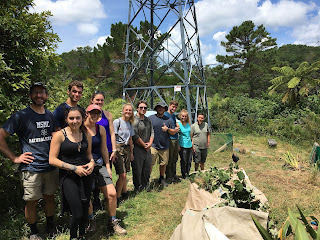Our group had an amazing day at our service learning project in Zealandia, the Karori Sanctuary in Wellington! First, we stopped in the education center on the property where we learned about how Zealandia was formed over millions of years. This occurred from the break up of Gondwanaland, the super continent of the Southern Hemisphere, and the shifting of Pacific and Australasian plates that has made New Zealand today. We watched a short film depicting how predators and people came to New Zealand and the overall effect it had on the native plants and wildlife.
We then moved into the sanctuary, which happens to be the world's first urban sanctuary set in the middle of New Zealand’s capital city, Wellington. New Zealand has many off shore islands that are sanctuaries that preserve the original bird, insect, and reptile species. The island sanctuaries inspired local people to create something of the same stature, just a lot closer to the people of New Zealand so that there was better access to it. The fence for the sanctuary took 3 years to develop, which included a few key elements that help keep predators out. These included a height of 1.8 meters tall or higher to keep cats out, a tight-knit metal wiring that the rodents could not fit through, along with having a cover on the top to keep possum, cats, and rats from climbing over. The fence also had a mesh wiring that goes under the ground 3 inches and out from the fence to keep animals that dig out.
Anne Jackson, Karori Education Ranger, explains the use of traps (bottom left in picture) to remove mammalian predators from the sanctuary.
As we made our way through the double gate system into the sanctuary, we started our 45min hike to where we would be clearing brush. Clearing the thorny blackberry bushes was a bunch of fun, even though it hurt every once in awhile. We were clearing the bushes to help clear more grazing area for the Takahe, a bird species who grazes on the low grass. The bushes over grow so quickly that it reduces the amount of area the Takahe has to roam, and to eat, and they could get stuck. We worked really hard to clear the bushes and had a great time doing it. We used clippers, shovels and reinforced gloves that were provided to us.
Our group working on removing blackberry plants, including both the above-ground and below-ground biomass!
We took a lunch break and enjoyed the shade. As we finished up lunch, Titu, one of the four Takahe's in the sanctuary came into the clearing, walked around and ate some food. The beautiful colors on his feathers were amazing, and it was cool to see how he walked and moved around. We finished taking pictures and moved on to walk to our next locations around the sanctuary.
Our group after finishing our removal of the blackberry bushes. Behind Dr. Mike Daven (Math & IT; furthest person to right), is Titu, the 20+ year old Takahe to inspect his newly remodeled habitat.
While walking around we got to see other species of birds such as New Zealand’s forest parrot, the Kaka, Saddlebacks, and Pied Shag, along with other bird species and Tuatara, the lone members of the Family Sphenodontidae, in their burrows. Overall, we had a wonderful day helping the sanctuary and learning more about the wildlife that is original to New Zealand along with the preservation efforts going on, helping it to continue to flourish.
Kaka, the New Zealand forest parrot, perched among the bird feeders. Each parrot takes a turn visiting the feeder to obtain a peanut.



No comments:
Post a Comment